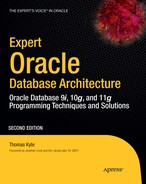I first met the Oracle RDBMS some time in 1988, or possibly 1987, when my manager dumped a small box on my desk and said something like: "There's this new product called Oracle just coming into the country. Play around with it for a few weeks and then tell us what it's good for."
The version was something like 5.0.22, and in those days it was a lot easier getting started with Oracle. The entire printed manual set—including Forms 2.0, SQL*Report, and everything else—would fit into a small briefcase and the documentation for the create table statement ran to about three pages.
If you check the PDF file for the 11.2 SQL reference manual, you'll find that create table currently starts at page 16-6 and runs on to page 16-79 for a total of 74 pages. The last time I checked the total page count was for 9i, and that was more than 20,000 pages—and I doubt if the number has dropped in 10g and 11g.
With three (fairly slim) manuals for 5.0.22, it didn't take me very long to learn about everything that Oracle was supposed to do and how to do it efficiently. There weren't many options, so there weren't many ways to do things wrong. But how do you get started today when the core of Oracle is hidden under a huge mass of options and features? Worse, the details you really need to understand are covered by a mountain of information that is nice to have, but not critical to getting started.
The answer is simple.
Step 1: Read the concepts manual so you have an idea of what it's all about.
Step 2: Read Tom Kyte's book so that you can follow a rational progression of learning and experimenting that leads you from your first "select 'hello world' from dual" to the day when you can confidently say things like "we should use a range partitioned IOT with these columns in the overflow for this table because ... ."
Tom combines three things in this book: a conversational style that makes it easier to read about technical details and understand the "why" behind the "how"; a structured "storyline" so that you see the text building towards a target rather than scattering a disjointed collection of random tips; and an array of carefully constructed demonstrations that teach you how things work and how you should work and think.
Consider just one example, indexing. There are many types of indexes, so we need a brief introduction to separate the different types. It's good to have an idea of how B-tree indexes (for example) actually work so that we can understand their strengths and weaknesses. Then we can move on to the idea of function-based indexes—indexes on "data that don't really exist." This gets us to the point of understanding what Oracle can do, but we can (and do) go further with what we can do with Oracle. So we see how we can put the pieces together to create an index that guarantees uniqueness across subsets of the data, we see how we can—on a huge data set—create a tiny, low-maintenance index that identifies exactly the data that we really want to access and minimizes the risk of the optimizer producing a silly execution plan.
In principle, it's all in the manuals, but only if we have the insight to take the naked descriptions of the available commands and see how we can use them to construct solutions to real problems. Tom Kyte supplies that insight, and then encourages you to go further in developing your own insights.
Frankly, if every DBA and developer in the world were made to work carefully through Tom Kyte's book, I'd probably have to start offering consultancy services to SQL Server users because the number of clients needing Oracle consultancy would drop dramatically.
Jonathan Lewis
